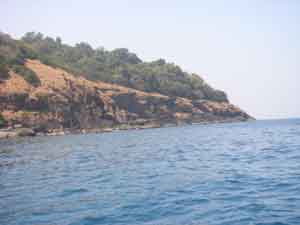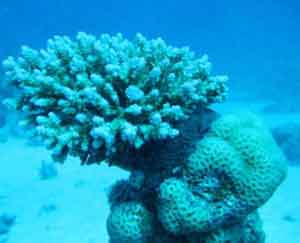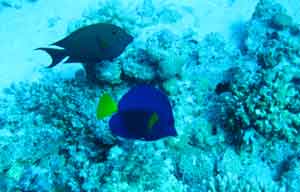Netrani: The unexplored paradise
By Swetha Amit | 27 May 2011
Discovering a hidden jewel of a surreal getaway is no doubt a delightful experience. One tends to feel like Christopher Columbus when he stumbled upon a mighty continent during his quest. The only difference was that this was an island, Netrani or Pigeon Island as it is called, tucked away deep inside the Arabian Sea. Its crystal clear waters vied with that of international holiday destinations. The rich marine life beneath the waves at Netrani took our breaths away.
 Little did we know that our diving certification course would turn into a fun expedition? When our instructor suggested the idea of finishing our course in a small seaside town in Indian waters, we were thrilled. This was despite the fact that the facilities offered would be very limited. The spirit of adventure surpassed that of expectations of luxury and we geared up for an exciting experience. After a rather tiring overnight journey from Mumbai, we landed up in the small town of Murudeshwar, which is on the Karnataka coast. We were greeted by the soft murmur of waves and a giant statue of Lord Shiva. After getting adequate rest, we assembled at the diving equipment shop the next day.
Little did we know that our diving certification course would turn into a fun expedition? When our instructor suggested the idea of finishing our course in a small seaside town in Indian waters, we were thrilled. This was despite the fact that the facilities offered would be very limited. The spirit of adventure surpassed that of expectations of luxury and we geared up for an exciting experience. After a rather tiring overnight journey from Mumbai, we landed up in the small town of Murudeshwar, which is on the Karnataka coast. We were greeted by the soft murmur of waves and a giant statue of Lord Shiva. After getting adequate rest, we assembled at the diving equipment shop the next day.
One with fishermen: After setting up our scuba diving gear, we boarded the boats that would ferry us to the dive spots. We were surprised to see that fishing boats were our transportation. With mixed feelings of apprehension and excitement, the five of us managed to climb on to the boats. The ride proved to be smooth, being blessed with good weather and friendly waves. The sparkling water at our dive spots left us gaping in awe. After essential instructions by our instructor, we soon jumped into the water one by one, lead by our guide. After relaxing for a few minutes on the surface, we proceeded to head down slowly and steadily.
 A different kind of nursery: This particular dive site was quite shallow in comparison to others, making it dive-friendly for beginners. We landed on gravel. After performing a few manoeuvres for our dive completion certificate, we proceeded to swim around in this little world. Colourful coral were present in abundance making it a strikingly resplendent world. We saw a giant moray eel burrowed in gravel beside some rocks. Varied schools of fish swam past us. The clownfish stood out among them, and was easily identifiable from the movie ‘Finding Nemo’. Our first dive lasted for around forty minutes before we headed back to our boats. After a lunch break, we did our second dive and exhibited a few more of our skills before our day ended.
A different kind of nursery: This particular dive site was quite shallow in comparison to others, making it dive-friendly for beginners. We landed on gravel. After performing a few manoeuvres for our dive completion certificate, we proceeded to swim around in this little world. Colourful coral were present in abundance making it a strikingly resplendent world. We saw a giant moray eel burrowed in gravel beside some rocks. Varied schools of fish swam past us. The clownfish stood out among them, and was easily identifiable from the movie ‘Finding Nemo’. Our first dive lasted for around forty minutes before we headed back to our boats. After a lunch break, we did our second dive and exhibited a few more of our skills before our day ended.
A rollercoaster ride: The boat ride on the second day was a rather bumpy one. The waves were restless and choppy. As we cruised along, the boat rocked to and fro and made us feel like we were on a rocking chair. One needs to anticipate such rides and ensure that one hasn't had a heavy meal. The other alternative is taking medications for sea sickness. We finally managed to reach our dive spot, a different one this time. It was called the Grand Central Station. After the usual set of instructions, we jumped into the sea ready to test our skills and explore the marine life beneath.
The Grand Central Station: We were given a warm welcome by the fish as soon as we landed. This was a different underwater haven altogether and busier in comparison to the Nursery. No wonder it was called the Grand Central. The dive site lived up to its name with variety in the shapes, sizes and colours of marine life. It was bordered by a gentle slope of corals, which gave it a fairy tale setting. As we ventured deeper, we were greeted by long barracudas that resembled pikes, with sharp, prominent, fang-like teeth. We also saw numerous parrot fish that added colour to the waters. Their bodies were thick and large with rough scales; prominent parrot-shaped mouths gave them their name. As we continued swimming, we spotted a pair of antennae sticking out from a crevice in a rock. It was a shy baby lobster which refused to venture out from its abode. Lobsters are known to be nocturnal by nature. Our 35-minute dive came to an end as we headed towards the surface for a break before our last dive. Our last dive for the day replicated our earlier one. We soon headed back to the shores on another rollercoaster ride.
 On dry land: We returned our equipment to the dive shop and headed back to the hotel feeling rather tired after a long day. We completed our written examination and were officially certified scuba divers. Having time on our hands, we decided to cruise around the small town of Murudeshwar. There seemed to be nothing much besides the temple of Lord Shiva and a busy marketplace. The temple was beautiful, well constructed and serene. After paying our homage to the deities, we proceeded to examine the marketplace. After which, we headed back to our hotel for dinner and a good sleep before boarding our train the next day.
On dry land: We returned our equipment to the dive shop and headed back to the hotel feeling rather tired after a long day. We completed our written examination and were officially certified scuba divers. Having time on our hands, we decided to cruise around the small town of Murudeshwar. There seemed to be nothing much besides the temple of Lord Shiva and a busy marketplace. The temple was beautiful, well constructed and serene. After paying our homage to the deities, we proceeded to examine the marketplace. After which, we headed back to our hotel for dinner and a good sleep before boarding our train the next day.
Netrani is ideal for those interested in either snorkelling or scuba diving. It is also a good weekend getaway from the bustling life of metropolitan cities. The entire trip was a relaxing one and made us wonder how many such destinations existed in India that were waiting to be explored.
How to get to Netrani
By air: Mangalore is the nearest airport, which is about 165 km from Murudeshwar. Other airports include Panaji and Hubli.
By rail: Murudeshwar is the nearest railway station, which can be reached by trains from either Mumbai or Mangalore.
By road: Netrani is well connected from Bhatkal, Karwar, Mangalore, Kollur and even Bangalore.
Where to stay
RNS Residency provides decent accommodation for a weekend. The rooms are clean. Meals are fresh and served on time. It is situated right next to the Shiva temple and offers a spectacular view of the Arabian Sea.
Cost
A weekend trip would cost around Rs15,000, inclusive of diving and overnight stay at the hotel.
Best time to visit
The best time to visit Netrani would be between the months of October to May. The weather is very pleasant and one can expect excellent visibility underwater. It is best to avoid this place during the monsoon months between June and September.



















